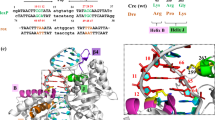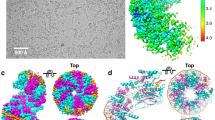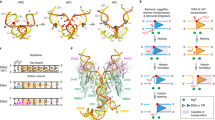Abstract
During site-specific DNA recombination, which brings about genetic rearrangement in processes such as viral integration and excision and chromosomal segregation, recombinase enzymes recognize specific DNA sequences and catalyse the reciprocal exchange of DNA strands between these sites. The bacteriophage recombinase Cre catalyses site-specific recombination between two 34-base-pair loxP sites. The crystal structure at 2.4 Å resolution of Cre bound to a loxP substrate reveals an intermediate in the recombination reaction, in which a Cre molecule has cleaved the substrate to form a covalent 3′-phosphotyrosine linkage with the DNA. Four recombinases and two loxP sites form a synapsed structure in which the DNA resembles models of four-way Holliday-junction intermediates. The Cre–loxP complex challenges models of site-specific recombination that require large changes in quaternary structure. Subtle allosteric changes at the carboxy termini of the Cre subunits may instead coordinate the cleavage and strand-exchange reactions.
This is a preview of subscription content, access via your institution
Access options
Subscribe to this journal
Receive 51 print issues and online access
$199.00 per year
only $3.90 per issue
Buy this article
- Purchase on Springer Link
- Instant access to full article PDF
Prices may be subject to local taxes which are calculated during checkout





Similar content being viewed by others
References
Craig, N. L. The mechanism of conservative site-specific recombination. Annu. Rev. Genet. 22, 77–105 (1988).
Stark, W. M., Boocock, M. R. & Sherratt, D. J. Catalysis by site-specific recombinases. Trends Genet. 8, 432–439 (1992).
Kwon, H. J., Tirumalai, R., Landy, A. & Ellenberger, T. Flexibility in DNA recombination: structure of the lambda integrase catalytic core. Science 276, 126–131 (1997).
Argos, P.et al. The integrase family of site-specific recombinases: regional similarities and global diversity. EMBO J. 5, 433–440 (1986).
Abremski, K. E. & Hoess, R. H. Evidence for a second conserved arginine residue in the integrase family of recombination proteins. Protein Eng. 5, 87–91 (1992).
Landy, A. Dynamic, structural, and regulatory aspects of lambda site-specific recombination. Annu. Rev. Biochem. 58, 913–949 (1989).
Abremski, K., Hoess, R. & Sternberg, N. Studies on the properties of P1 site-specific recombination: evidence for topologically unlinked products following recombination. Cell 32, 1301–1311 (1983).
Abremski, K. & Hoess, R. Bacteriophage P1 site-specific recombination. Purification and properties of the Cre recombinase protein. J. Biol. Chem. 259, 1509–1514 (1984).
Sternberg, N., Hamilton, D., Austin, S., Yarmolinsky, M. & Hoess, R. Site-specific recombination and its role in the life cycle of bacteriophage P1. Cold Spring Harbor Symp. Quant. Biol. 1, 297–309 (1981).
Sauer, B. Manipulation of transgenes by site-specific recombination: use of Cre recombinase. Meth. Enzymol. 225, 890–900 (1993).
Kilby, N. J., Snaith, M. R. & Murray, J. A. Site-specific recombinases: tools for genome engineering. Trends Genet. 9, 413–421 (1993).
Tsurushita, N., Fu, H. & Warren, C. Phage display vectors for in vivo recombination of immunoglobulin heavy and light chain genes to make large combinatorial libraries. Gene 172, 59–63 (1996).
Qin, M., Bayley, C., Stockton, T. & Ow, D. W. Cre recombinase-mediated site-specific recombination between plant chromosomes. Proc. Natl Acad. Sci. USA 91, 1706–1710 (1994).
Lakso, M.et al. Targeted oncogene activation by site-specific recombination in transgenic mice. Proc. Natl Acad. Sci. USA 89, 6232–6236 (1992).
Betz, U. A., Vosshenrich, C. A., Rajewsky, K. & Muller, W. Bypass of lethality with mosaic mice generated by Cre-loxP-mediated recombination. Curr. Biol. 6, 1307–1316 (1996).
Zou, Y. R., Muller, W., Gu, H. & Rajewsky, K. Cre-loxP-mediated gene replacement: a mouse strain producing humanized antibodies. Curr. Biol. 4, 1099–1103 (1994).
Kuhn, R., Schwenk, F., Aguet, M. & Rajewsky, K. Inducible gene targeting in mice. Science 269, 1427–1429 (1995).
Metzger, D., Clifford, J., Chiba, H. & Chambon, P. Conditional site-spedific recombination in mammalian cells using a ligand-dependent chimeric Cre recombinase. Proc. Natl Acad. Sci. USA 92, 6991–6995 (1995).
Hickman, A. B., Waninger, S., Scocca, J. J. & Dyda, F. Molecular organization in site-specific recombination: the catalytic domain of bacteriophage HP1 integrase at 2.7 Å resolution. Cell 89, 227–237 (1997).
Subramanya, H. S.et al. Crystal structure of the site-specific recombinase, XerD. EMBO J. 17, 5178–5187 (1997).
Schultz, S. C., Shields, G. C. & Steitz, T. A. Crystallization of Escherichia coli catabolite gene activator protein with its DNA-binding site. The use of modular DNA. J. Mol. Biol. 213, 159–166 (1990).
Pargellis, C. A., Nunes-Duby, S., de, V. L. & Landy, A. Suicide recombination substrates yield covalent lambda integrase-DNA complexes and lead to identification of the active site tyrosine. J. Biol. Chem. 263, 7678–7685 (1988).
Sigal, N. & Alberts, B. Genetic recombination: the nature of crossed strand-exchange between two homologous DNA molecules. J. Mol. Biol. 71, 789–793 (1972).
Duckett, D. R.et al. The structure of the Holliday junction, and its resolution. Cell 55, 79–89 (1988).
Hoess, R. H. & Abremski, K. Interaction of the bacteriophage P1 recombinase Cre with the recombining site loxP. Proc. Natl Acad. Sci. USA 81, 1026–1029 (1984).
Hoess, R., Abremski, K., Irwin, S., Kendall, M. & Mack, A. DNA specificity of the Cre recombinase resides in the 25 kDa carboxyl domain of the protein. J. Mol. Biol. 216, 873–882 (1990).
Chen, J. W., Lee, J. & Jayaram, M. DNA cleavage in trans by the active site tyrosine during Flp recombination: switching protein partners before exchanging strands. Cell 69, 647–658 (1992).
Rafferty, J. B.et al. Crystal structure of DNA recombination protein RuvA and a model for its binding to the Holliday junction. Science 274, 415–420 (1996).
Lavery, R. & Sklenar, H. The definition of generalised helicoidal parameters and of axis curvature for irregular nucleic acids. J. Biomol. Struct. Dynam. 6, 63–91 (1988).
Hoess, R. H., Wierzbicki, A. & Abremski, K. The role of the loxP spacer region in P1 site-specific recombination. Nucleic Acids Res. 14, 2287–2300 (1986).
Stark, W. M., Sherratt, D. J. & Boocock, M. R. Site-specific recombination by Tn3 resolvase: topological changes in the forward and reverse reactions. Cell 58, 779–790 (1989).
Kitts, P. A. & Nash, H. A. Homology-dependent interactions in phage lambda site-specific recombination. Nature 329, 346–348 (1987).
Nunes-Duby, S., Azaro, M. A. & Landy, A. Swapping DNA strands and sensing homology without branch migration in lambda site-specific recombination. Curr. Biol. 5, 139–148 (1995).
Arciszewska, L. K., Grainge, I. & Sherratt, D. J. Action of site-specific recombinases XerC and XerD on tethered Holliday junctions. EMBO J. 16, 3731–3743 (1997).
Azaro, M. A. & Landy, A. The isometric preference of Holliday junctions influences resolution bias by lambda integrase. EMBO J. 16, 3744–3755 (1997).
Stark, W. M. & Boocock, M. R. Gatecrashers at the catalytic party. Trends Genet. 11, 121–123 (1995).
Shaikh, A. C. & Sadowski, P. D. The Cre recombinase cleaves the lox site in trans. J. Biol. Chem. 272, 5695–5702 (1997).
Nunes-Duby, S.et al. Lambda integrase cleaves DNA in cis. EMBO J. 13, 4421–4430 (1994).
Arciszewska, L. K. & Sherratt, D. J. Xer site-specific recombination in vitro. EMBO J. 14, 2112–2120 (1995).
Blakely, G. W. & Sherratt, D. J. Cis and trans in site-specific recombination. Mol. Microbiol. 20, 233–238 (1996).
Qian, X. H., Inman, R. B. & Cox, M. M. Protein-based asymmetry and protein-protein interactions in FLP recombinase-mediated site-specific recombination. J. Biol. Chem. 265, 21779–21788 (1990).
Van Duyne, G. D., Ghosh, S., Maas, W. K. & Sigler, P. B. Structure of the oligomerization and L-arginine binding domain of the arginine repressor of Escherichia coli. J. Mol. Biol. 256, 377–391 (1996).
Otwinowski, Z. in CCP4 Proc.80-88 (Daresbury Laboratory, Warrington, UK, (1991)).
Abrahams, J. P. & Leslie, A. G. W. Methods used in the structure determination of bovine mitochontrial F1 ATPase. Acta Crystallogr. D 52, 30–42 (1996).
Rice, L. M. & Brunger, A. T. Torsion angle dynamics: reduced variable conformational sampling enhances crystallographic structure refinement. Prot. Struct. Funct. Genet. 19, 277–290 (1996).
Jones, T. A., Zou, J. Y., Cowan, S. W. & Kjeldgaard, M. Improved methods for building protein models in electron density maps and the location of errors in these models. Acta Crystallogr. A 47, 110–119 (1991).
Jiang, J. S. & Brunger, A. T. Protein hydration observed by X-ray diffraction: solvation properties of penicillopepsion and neuraminidase crystal structures. J. Mol. Biol. 243, 100–115 (1994).
Parkinson, G., Vojtechovsky, J., Clowney, L., Brunger, A. T. & Berman, H. New parameters for the refinement of nucleic acid-containing structures. Acta Crystallogr. D 52, 57–64 (1996).
Kraulis, P. MOLSCRIPT: a program to produce both detailed and schematic plots of protein structures. J. Appl. Crystallogr. 24, 946–950 (1991).
Carson, M. Ribbons 2.0. J. Appl. Crystallogr. 24, 958–961 (1991).
Acknowledgements
We thank L. Berman and Z. Yin for access to and help with the NSLS X25 beamline, W. Hendrickson and C. Ogata for access to and help with the NSLS X4A beamline, J. Ni for assistance with data collection, Y.-M. Zheng for technical support, R. Hoess for valuable discussions, and M. Lemmon, H. Nelson, M. Lewis, H. Lu and K. Ferguson for helpful comments. This work was partly supported by ACS IRG and NCI core support grants through the V. Penn Cancer Center.
Author information
Authors and Affiliations
Rights and permissions
About this article
Cite this article
Guo, F., Gopaul, D. & Van Duyne, G. Structure of Cre recombinase complexed with DNA in a site-specific recombination synapse. Nature 389, 40–46 (1997). https://doi.org/10.1038/37925
Received:
Accepted:
Issue Date:
DOI: https://doi.org/10.1038/37925
This article is cited by
-
Systematic dissection of key factors governing recombination outcomes by GCE-SCRaMbLE
Nature Communications (2022)
-
The development of genome editing tools as powerful techniques with versatile applications in biotechnology and medicine: CRISPR/Cas9, ZnF and TALE nucleases, RNA interference, and Cre/loxP
ChemTexts (2021)
-
Human germline editing in the era of CRISPR-Cas: risk and uncertainty, inter-generational responsibility, therapeutic legitimacy
BMC Medical Ethics (2020)
-
A non-invasive far-red light-induced split-Cre recombinase system for controllable genome engineering in mice
Nature Communications (2020)
-
Genome targeting by hybrid Flp-TAL recombinases
Scientific Reports (2020)
Comments
By submitting a comment you agree to abide by our Terms and Community Guidelines. If you find something abusive or that does not comply with our terms or guidelines please flag it as inappropriate.



